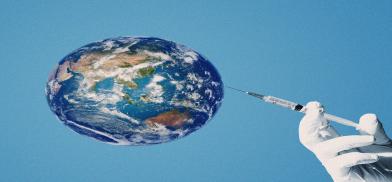India can help reduce the global vaccine inequity
Though the invention of vaccines is good news to the world, no one is safe from Covid-19 until everyone is safe and vaccinated

2021 will go down as one of the most turbulent years in the century. Millions died across the globe; hundreds of thousands perished in India due to Covid-19. The pandemic triggered the worst economic crisis since 1930. Major economies lost at least 4 percent of their GDP in 2020 and 2021. Due to that, government revenue declined. In addition, it led to employment loss, low salaries and demand fall. But the government's expenses shot up -- on healthcare, vaccination and welfare schemes.
Since 2020, the pandemic has disrupted health services and stretched the global health system beyond its limits. It made difficult for people to pay for healthcare. Due to the pandemic, millions were pushed into extreme poverty; many in the middle class were pushed below the poverty line because of healthcare payments. The pandemic hit worst on more vulnerable groups like those in the informal sector and daily wage labourers.
An additional 207 million people in the world could be pushed below the poverty line by 2030 due to Covid-19 and lockdowns. The total number of extreme world poverty will rise to more than a billion. Due to this, child labour and trafficking are set to rise. More than 8 million children are being forced into begging and child labour in Asia alone because their parents cannot afford to buy enough food.
In addition, the US withdrawal from Afghanistan has added fuel to the situation. Today, 97 percent of the Afghan people will be pushed into poverty by the middle of June 2022.
Pandemic shockwaves
The pandemic has disrupted trade and investments, especially in tourism, aviation, and manufacturing sectors. Millions lost their jobs in these sectors. During this crisis, some sectors like e-commerce, IT, pharma and healthcare industries benefited from Covid-19 and showed some economic growth to control the damage.
When we look at India's 2021, the second Covid wave in March was much more devastating. More than 4 lakh people died and millions suffered. On the other hand, India had vaccinated more than 145 crore people in 2021. Now India is vaccinating those in the 15-18 age group and is ready to give booster doses to frontline workers and those above 60 years. It is a significant achievement for a developing country like India.
At the same time, the pandemic led to large-scale job cuts, shutting down of industries and MSMEs and catastrophic income shocks. Pre-Covid times, around 26.5 crore rural people were poor; this is expected to rise to 40 crore. Another 4 to 5 crore will be pushed into poverty in urban areas. That means additional 20 crore people will be pushed into poverty this year.
The Indian government announced Rs 20 lakh crore for economic relief to the poor to address these issues driven by Covid-19. But it needs to be careful in implementing national food security, direct cash transfer, health insurance, MNREGA and other welfare schemes. These schemes can prevent extreme poverty and impoverishment.
India can address disparity
One good news was that scientists invented vaccination for corona in a short period. It could help the world protect itself from the virus. Though the invention of vaccines is good news to the world, no one is safe from Covid-19 until everyone is safe and vaccinated.
Due to the disparity of vaccination, new variants may emerge, and it may weaken the vaccines. WHO has set a target of vaccinating 70 percent of the global population by the middle of June 2022. Developed countries like the US and UK have vaccinated more than 60 percent of their population.
But poor countries like Nigeria, Papua New Guinea and Sudan have vaccinated less than 3 percent. There could be many reasons for the vaccination disparity -- wealthy countries hold more vaccines for their citizens; the cost of Western vaccines is also high. A country like India can address the disparity in vaccination.
India produced 31 crore (310 million) vaccine doses in December, utilizing half of the production. The remaining 15 crore (150 million) vaccines will be exported to poor countries. Although most developed countries vaccinated their people, they are witnessing another wave of the pandemic. Once again, it increases the pressure on the governments.
(The author is a Research Scholar, IIT Varanasi, and General Secretary, Towards Better India. The views expressed are personal. He can be contacted at kvkraoiitm@gmail.com)









Post a Comment